-
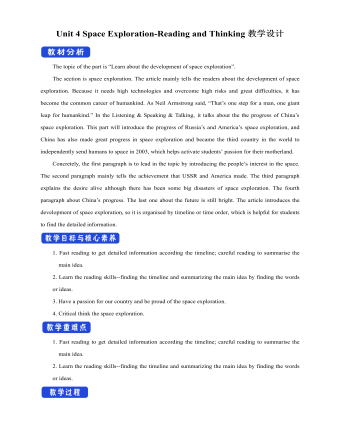
新人教版高中英语必修3Unit 4 Space Exploration-Reading and Thinking教学设计一
Q4: What is the function of the International exploration ?Having astronauts from different countries on boardQ5: What can you learn from Para 4 ?China has made great achievements in exploring spaceQ6: What is the attitude to the space exploration ?SupportiveStep 6 Post reading---RetellPeople have always wanted to learn more about space. Before the mid-20th century, most people felt (1)_________ (travel) into space was an impossible dream. However, (2)____ the help of scientists, peoplesucceeded in realizing their dream (3) _________ (explore) space. On 4 October 1957, the Sputnik 1 satellite (4) ____________(launch) by the USSR. (5) ________________ scientists try to make sure nothing goes wrong, accidents can still happen. These disasters made everyone(6)___________(disappoint), but people still believe in the importance of (7) ________(carry) on space exploration. In 2003, China became the third country to (8)_____________ (independent) send humans into space. Then Shenzhou 6 and 7 completed (9)____ second manned orbit and the first Chinese spacewalk. In spite of the difficulties, scientists hope future (10)__________ (discovery) will not only enable us to understand the universe but also help us survive well into the future.Answers: 1. travelling 2. with 3. to explore 4. was launched 5. Although6. disappointed 7. carrying 8. independently 9. a 10. discoveriesStep 6 Post reading---Critical thinkingQ1: What do you think of the space exploration ? I think it is beneficial to us. Through further study of space, people will make full use of it in the future, such as the space experiments by Wang Yaping in Tian Gong 1.Q2: If you are determined to be an astronaut, what should you prepare at present ?First of all, I should study hard to get a related college degree. Besides, I must keep mental and physical healthy.Step 7. HomeworkTry to summarize the structure of the article by a mind map.
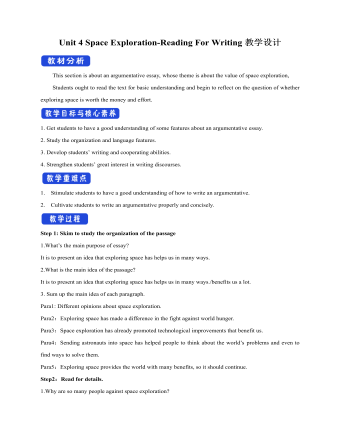
新人教版高中英语必修3Unit 4 Space Exploration-Reading For Writing教学设计一
另一方面,其余的人反对这个计划,因为它可能会导致一些不好的影响。7.I hold the belief that space exploration not only enable us to understand how the universe began but also help us survived well into the future.我坚信探索太空不仅能够使我们了解宇宙的起源而且能够帮助我们更好地走进未来。8.I think we should spend more time and money exploring space so as to provide new and better solutions to people's shortterm and longterm problems.为了给人类的短期和长期问题提供更新和更好的解决方法,我认为我们应该花更多的时间和金钱来探索太空。9.From my point of view,it is wrong of young people to depend on their telephones too much,which may do harm to both their physical and mental health.在我看来,年轻人过度依赖手机是不对的,因为它们可能会对他们的身心健康都有害。最近你班同学就“人类是否应该进行宇宙探索”这个问题进行了激烈的讨论。有人认为,探索宇宙不仅让人类更好地了解宇宙的发展,还可以用来指导农业生产,以及把一些探索太空的高新技术用于现实生活;也有一些人认为探索太空花掉了大量的人力物力;影响了人们的生活水平。请你根据以下情况写一篇报告并发表自己的观点。注意:1.写作内容应包括以上全部要点,可适当发挥,使上下文连贯;
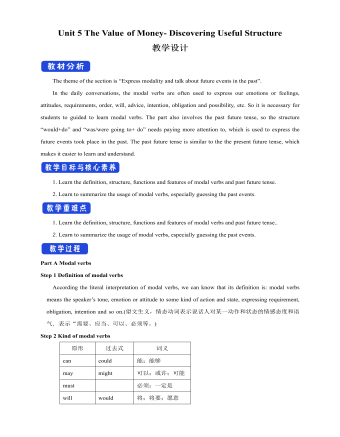
新人教版高中英语必修3Unit 5 The Value of Money- Discovering Useful Structure教学设计
Step 3 Meaning1. 过去将来时表示从过去某一时间来看将要发生的动作或存在的状态, 常用在宾语从句中。一般由“would/should +动词原形”构成。She hoped that they would meet again someday. 她希望将来有一天他们能再见面。2. was/were going to+动词原形: 表示过去将要发生或很有可能发生的动作, 常用于口语中, 表示预言、意图或者打算等。He was going to start work the following week. 他打算下星期开始工作。3. was/were about to do: 常用来表示即将发生的动作, “刚要/正要做……”。注意该结构不与任何时间状语连用。I felt that something terrible was about to happen. 我感到某种可怕的事情即将发生。4.was/were to do: 表示“曾计划做某事”, 如果表示“本来计划做某事, 动作没实现”, 则需用 “was/were to have done”。She said she was to have told me about the accident. 她说她本来想告诉我关于事故的事。5.Start, go, come, leave, see, meet等动词的过去进行时: 表示就过去某一时刻而言即将发生的动作。She was coming later. 她随后就来。I had just put on my overcoat and was leaving to visit a friend of mine. 我刚穿上外套要去看我的一个朋友。
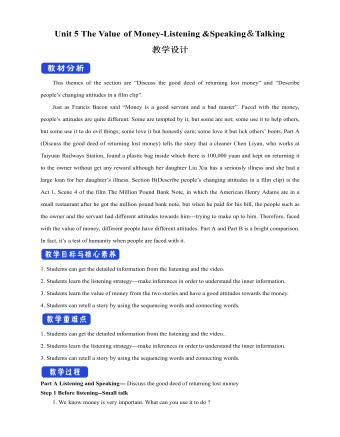
新人教版高中英语必修3Unit 5 The Value of Money-Listening &Speaking&Talking教学设计
4. A:We’d like to have someone to say a word at the beginning to welcome the group.B:↙Who?A:We thought that you or Dr.Johnson might do it.B用降调说Who,其意思是问,对方想让谁在开场时致欢迎词。Step 6 Pronunciation---Practice1. Listen to the short conversation and mark the intonation with ↗, ↙ or ↙, ↗. Then discuss with a partner what they intend to convey by using different intonation.Owner: You know what ?↗ It’s a million-pound bank note↙.Waiter 1: Really ?↗(question)Waiter 2: Really !↙(unbelievable and surprised)Waiter 3: Really ?!↙↗(first question then surprised)2. Listen to the conversations. Underline the parts that are stressed and mark the intonation. Then talk about the implied meanings of the responses with different intonations. Listen again and repeat.1) Henry: It’s a nice suit.Owner: Oh, it’s perfect!↙(The intonation means it is very suitable for Henry.)2) Henry: Well, that’s very kind of you.Owner: Kind, sir ?↗(what you said is not right) No, it’s kind of you. You must come whenever you want and have whatever you like. Just having you sit here is a great honour !!↙(welcome you to come again)3)Henry:Well, to be honest, I have none. Oliver:(happily) What luck!(excited) Brother↗, what luck!↙(It means “Didn’t you hear it?”)Henry: Well, it may seem lucky to you but not to me!↗(angry) If this is your idea of some kind of joke, I don’t think it’s very funny. Now if you’ll excuse me, I ought to be on my way.↙(If so, I would leave.)Roderick: Please don’t go↙...(hope Henry can wait for a moment)Part B Viewing and Talking---Describe people’s changing attitudes in a film clipStep 1 Before-listening---Tell the filmYou are going to watch part of the film The Million Pound Bank Note. Look at these photos and guess what happens in the film.
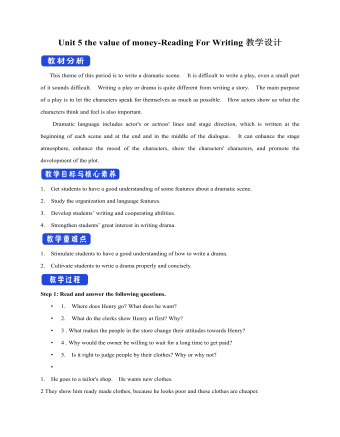
新人教版高中英语必修3Unit 5 the value of money-Reading For Writing教学设计一
【参考范文】Narrator:(Henry is smiling as he leaves the restaurant. As he is walking down the street, he sees a sign for a place that cuts hair. He decides to get it cut. )H=Henry;B=Barber;R=rude manH:Good afternoon, I'd like to get a cut, if I may. (The barber looks at Henry's hair and continues cutting another man's hair. )Er, I'd really like a haircut. As you can see it's much too long. B:(in a rude manner) Yes, I can see that. Indeed, I can. H:Fine, well I'll have a seat then. (He sits in one of the barber's chairs. The barber turns to look at Henry. )B:It's quite expensive here, you know!Are you sure you can afford it?H:Yes. I think so. (In comes the rude man. )R:Hey you there. I need a haircut quickly. Can you do me straightaway?B:All right, then, get in the chair and I'll see what I can do. R:Thank you. (sits down in one of the barber's chairs)H:Excuse me, but I was here first. Aren't you going to do my hair first?B:This man's in a hurry. H:Well so am I!I insist that you cut my hair first. B:OK, but I'll have to be quick. This gentleman is waiting. H:Thank you. (They both become quiet. After his hair is cut, the barber tells Henry how much he must pay. Henry shows the barber the bank note. )B:Why, Mr . . . (looks shocked)H:Adams. Henry Adams. I'm sorry, I don't have any change. R:You're that Mr Adams! Well,I'm glad I waited or I might never have known it was you. B:Why, Mr Adams, please don't worry!(wearing a big smile) Nothing to worry about!Nothing at all!Please come back any time, even if you only need too little hairs cut!It will be my honour to serve you!
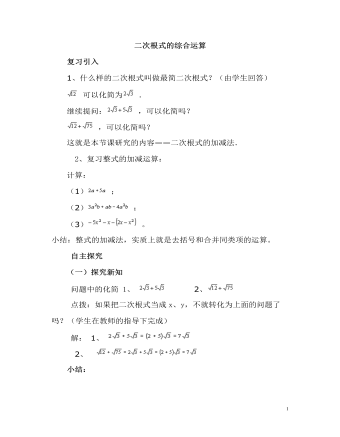
北师大初中数学八年级上册二次根式的混合运算2教案
本节课开始时,首先由一个要在一块长方形木板上截出两块面积不等的正方形,引导学生得出两个二次根式求和的运算。从而提出问题:如何进行二次根式的加减运算?这样通过问题指向本课研究的重点,激发学生的学习兴趣和强烈的求知欲望。本节课是二次根式加减法,目的是探索二次根式加减法运算法则,在设计本课时教案时,着重从以下几点考虑:1.先通过对实际问题的解决来引入二次根式的加减运算,再由学生自主讨论并总结二次根式的加减运算法则。2.四人小组探索、发现、解决问题,培养学生用数学方法解决实际问题的能力。3.对法则的教学与整式的加减比较学习。在理解、掌握和运用二次根式的加减法运算法则的学习过程中,渗透了分析、概括、类比等数学思想方法,提高学生的思维品质和兴趣。
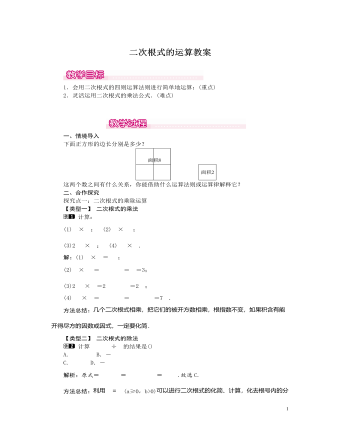
北师大初中数学八年级上册二次根式的运算1教案
1.会用二次根式的四则运算法则进行简单地运算;(重点)2.灵活运用二次根式的乘法公式.(难点)一、情境导入下面正方形的边长分别是多少?这两个数之间有什么关系,你能借助什么运算法则或运算律解释它?二、合作探究探究点一:二次根式的乘除运算【类型一】 二次根式的乘法计算:(1)3×5; (2)13×27;(3)2xy×1x; (4)14×7.解:(1)3×5=15;(2)13×27=13×27=9=3;(3)2xy×1x=2xy×1x=2y;(4)14×7=14×7=72×2=72.方法总结:几个二次根式相乘,把它们的被开方数相乘,根指数不变,如果积含有能开得尽方的因数或因式,一定要化简.【类型二】 二次根式的除法计算a2-2a÷a的结果是()A.-a-2 B.--a-2C.a-2 D.-a-2解析:原式=a2-2aa=a(a-2)a=a-2.故选C.
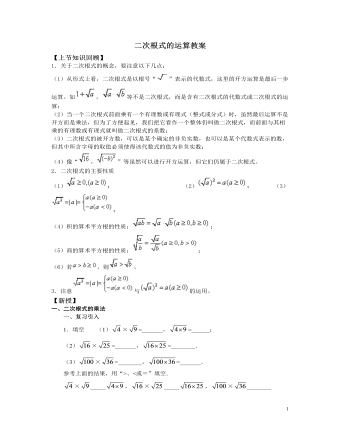
北师大初中数学八年级上册二次根式的运算2教案
1.关于二次根式的概念,要注意以下几点:(1)从形式上看,二次根式是以根号“ ”表示的代数式,这里的开方运算是最后一步运算。如 , 等不是二次根式,而是含有二次根式的代数式或二次根式的运算;(2)当一个二次根式前面乘有一个有理数或有理式(整式或分式)时,虽然最后运算不是开方而是乘法,但为了方便起见,我们把它看作一个整体仍叫做二次根式,而前面与其相乘的有理数或有理式就叫做二次根式的系数;(3)二次根式的被开方数,可以是某个确定的非负实数,也可以是某个代数式表示的数,但其中所含字母的取值必须使得该代数式的值为非负实数;(4)像“ , ”等虽然可以进行开方运算,但它们仍属于二次根式。2.二次根式的主要性质(1) ; (2) ; (3) ;(4)积的算术平方根的性质: ;(5)商的算术平方根的性质: ;
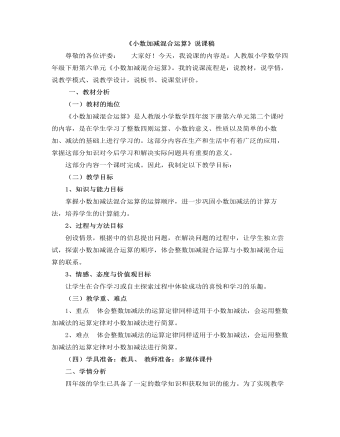
小学数学人教版四年级下册《小数加减法的混合运算》说课稿
【设计意图】新课前让学生对小数加减和整数加减混合运算的关系进行猜想,既抓住了本课的重点,同时很自然地让学生去体会知识之间的联系。(二)创设情境,发现问题出示情境图,师:从图中你获得哪些信息?你能提出什么问题?然后学生提问(对于学生提出的每个问题,教师作出适当评论。) 教师板书:一共花了多少钱?【设计意图】以学生自主探索为主,让学生在探索过程中发现规律,培养学生的归纳概括能力。(三)合作探究,解决问题解决第一个问题:一共花了多少钱? 教师提出要求:用两种方法解答。小组讨论,讨论后学生尝试独立在练习本上完成。 教师巡视,个别指导。(5分钟)【设计意图】充分体现教为主导、学为主体的原则。(四)展示交流,内化提升1、待大部分学生完成后,请两名学生把自己的解答板演到黑板上。组织学生评价:(1)教师概括:这两种解答方法的意义不相同,第一种解法是用脱式计算。第二种解法是用竖式计算少。
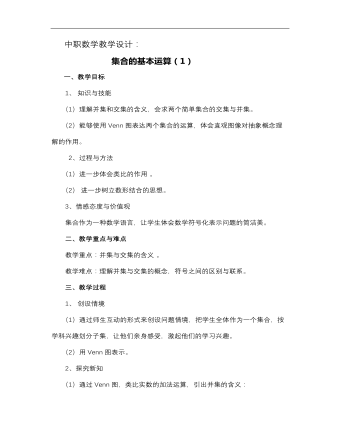
【高教版】中职数学基础模块上册:1.3《集合的运算》优秀教案
集合的基本运算(1) 一、教学目标 1、 知识与技能 (1)理解并集和交集的含义,会求两个简单集合的交集与并集。 (2)能够使用Venn图表达两个集合的运算,体会直观图像对抽象概念理解的作用。 2、过程与方法 (1)进一步体会类比的作用 。 (2) 进一步树立数形结合的思想。 3、情感态度与价值观 集合作为一种数学语言,让学生体会数学符号化表示问题的简洁美。 二、教学重点与难点 教学重点:并集与交集的含义 。 教学难点:理解并集与交集的概念,符号之间的区别与联系。

数据的整理教案教学设计
一、课前准备师:同学们想一想,你同父母一起去商店买衣服时,衣服上的号码都有哪些,标志是什么?学生:我看到有些衣服上标有M、S、L、XL、XXL等号码.但我不清楚代表的具体范围,适合什么人穿,但肯定与身高、胖瘦有关.师:这位同学很善动脑,也爱观察.S代表最小号,身高在150~155cm的人适合穿S号.M号适合身高在155~160cm的人着装……厂家做衣服订尺寸也并不是按所有人的尺寸定做,而是按某个范围分组批量生产.你觉得这种生产方法有什么优点?学校要为同学们订制校服,为此小明调查了他们班50名同学的身高,结果(单位cm).如下
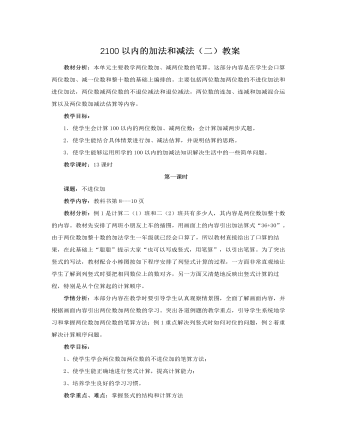
人教版新课标小学数学二年级上册2100以内的加法和减法(二)教案
教材分析:例4是让学生判断妈妈要买三种生活用品,带100元钱够不够。可以结合这种生活中经常出现的情景,使学生认识到,在日常生活中,有时需要进行精确计算,有时根据实际的需要只要估算出大致的结果就可以了,便于学生更完整、全面、深刻地认识数学的功能。估算的策略是多样化的,可以用连加,也可以用连减,还可以用加减混合,中间包含了加法的估算和减法的估算。教材上呈现了两种估算策略,有一名学生用连减的方法先估算出100-28大约得70,再估算出70-43大约得30,从而判断用剩下的钱买水杯还够,两步计算中都运用了估算。另一名学生先用加法估算出28+43大约得70,再口算出大约还剩30元,从而得出买水杯还够的结论,第一步计算运用了估算,第二步是精确计算。由于每个个体的思维方式和思维水平不同,所采取的估算策略也是不同的,教材上除了提供这两种估算策略以外,还有一名学生提出问题:“还可以怎样算呢?”提示教师在教学时让学生灵活采用适合自己的估算方法,体现了算法多样化的思想。
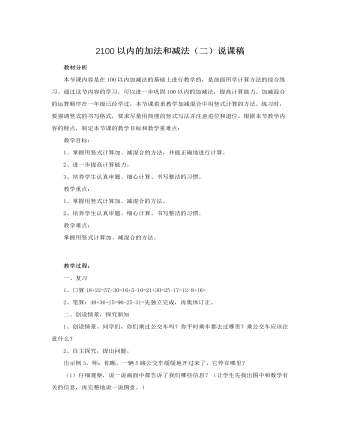
人教版新课标小学数学二年级上册2100以内的加法和减法(二)说课稿
加减混合是在连加连减的基础上进行的,学生有了一定的基础,在计算方法上没有什么大的问题,那么我就重要引导学生理解加减混合运算的意义。本课是从学生熟悉的乘坐公共汽车的生活情境引入的。教学时,我让学生用数学语言描述情境图中的“动作过程”,提出问题,并联系过程列式计算。学生都有乘公交车的经历,所以理解起来非常容易。这类加减混合式题是在连加、连减的基础上进行教学的,由于运算顺序与连加、连减的顺序相同,所以教学时让学生进行类推,先填好分步计算的第一个竖式,并计算出得数,再填写第二步计算的竖式,并计算出结果,然后让学生自己想简便写法的竖式。把学生的主动探索和老师的适时引导有机结合,使学生再轻松愉快的氛围中提高学习能力。
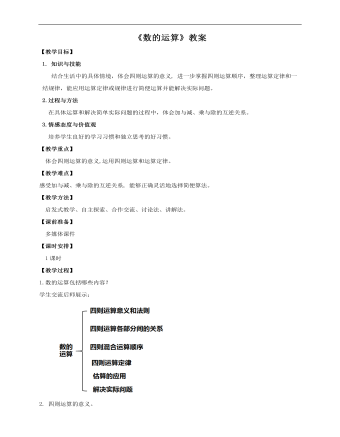
小学数学人教版六年级下册《第二课数的运算》教案说课稿
2.四则运算的意义。(1)知识梳理师:我们学过哪些运算?举例说明这些运算的含义。生:把两个(或几个)数合并成一个数的运算,叫做加法。 已知两个加数的和与其中的一个加数,求另一个加数的运算,叫做减法。 求几个相同加数的和的简便运算。 已知两个因数的积与其中一个因数,求另一个因数的运算。 师:整数、小数、分数四则运算有什么相同点?学生交流后师总结:加减法:都是把相同计数单位的数相加减。乘除法:小数乘除法把除数转化成整数再计算。分数除法要转化成分数乘法计算。师:整数、小数、分数四则运算有什么不同点?生:小数乘、除法还要在计算结果上确定小数点的位置,分数除法转化后乘的是除数的倒数。师:如果有0或者1参与四则运算,有哪些特殊情况?(学生讨论交流)生:任何数加减0都得原数。
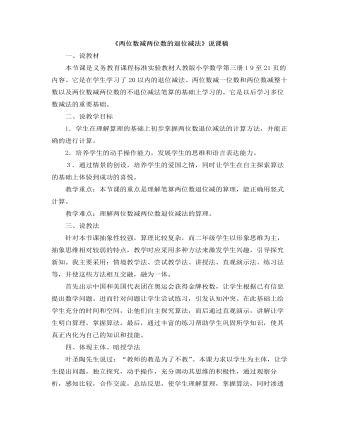
小学数学人教版二年级上册《两位数减两位数的退位减法》说课稿
一、说教材本节课是义务教育课程标准实验教材人教版小学数学第三册19至21页的内容。它是在学生学习了20以内的退位减法、两位数减一位数和两位数减整十数以及两位数减两位数的不退位减法笔算的基础上学习的。它是以后学习多位数减法的重要基础。 二、说教学目标 1.学生在理解算理的基础上初步掌握两位数退位减法的计算方法,并能正确的进行计算。 2.培养学生的动手操作能力,发展学生的思维和语言表达能力。 3.通过情景的创设,培养学生的爱国之情,同时让学生在自主探索算法的基础上体验到成功的喜悦。 教学重点:本节课的重点是理解笔算两位数退位减的算理,能正确用竖式计算。 教学难点:理解两位数减两位数退位减法的算理。三、说教法 针对本节课抽象性较强,算理比较复杂,而二年级学生以形象思维为主,抽象思维相对较弱的特点,教学时应采用多种方法来激发学生兴趣,引导探究新知。我主要采用:情境教学法、尝试教学法、讲授法、直观演示法、练习法等,并使这些方法相互交融,融为一体。
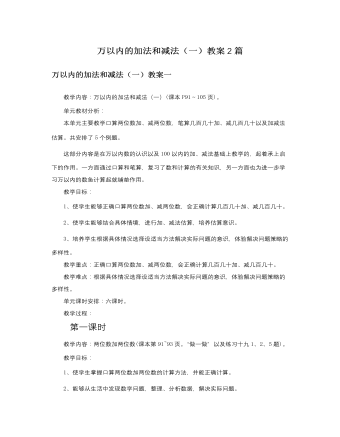
人教版新课标小学数学二年级下册万以内的加法和减法(一)教案2篇
3.小结。引导学生归纳两位数加减法的口算步骤:要把加上或减去的两位数看成一个整十数和一个一位数,先算两位数加、减整十数,再算两位数加减一位数。三、巩固练习课本第93页的做一做。分别指名口算,并说说怎么想的。四、全课总结1.根据学生回答,教师归纳小结并出示课题:口算两位数加、减两位数。2.口算两位数加、减两位数应注意什么?五、布置作业教后反思《标准》提倡算法多样化,目的是提倡学生个性化的学习。本单元仍然注意体现这一理念,如本课时教学口算两位数加、减两位数时,既呈现了口算方法,还出现了在脑中想竖式的方法;在教学笔算时,还出现口算的方法。其目的就是鼓励学生展开思路,在交流、比较的基础上不断地完善自己的想法,学习计算方法。
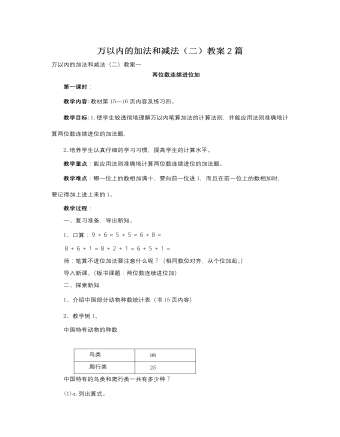
人教版新课标小学数学三年级上册万以内的加法和减法(二)教案2篇
●教学内容:教科书第27页的内容。●教学目标:①通过创设具体的情境,使学生初步学会加法的验算,并通过加法验算方法的交流、让学生体会算法的多样化。②培养学生探索合作交流的意识和能力。③让学生用所学到的验算知识去解决生活中的问题,体会用数学的乐趣。●教具准备:老师准备挂图或课件。●教学过程:创设情境、导入新课。师:同学们,你们与爸爸、妈妈去超市买过东西吗?生:互相说说,再请同学发表意见。师:(挂图1)我们来看挂图,小明和妈妈去超市买东西,从图1中你看到了什么?生1:从图1中我看到了小明妈妈买了一套135元的运动服和一双48元的运动鞋。生2:从图1中我看到小明妈妈给了售货员200元。生3:要知道一套运动服和一双运动鞋一共要多少元?应用加法计算。师:全班动手计算。板书:135+48=183(元)
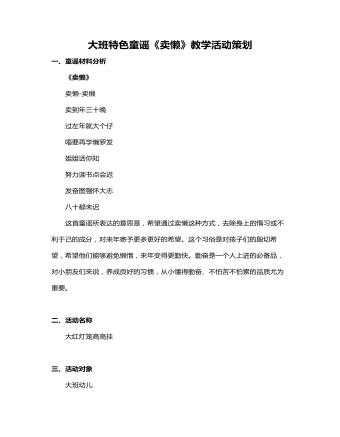
《卖懒》教学设计教案
1.制作红灯笼师:(展示漂亮的灯笼)小朋友们想不想自己亲手制作一个呢?生:好呀师:那小朋友们知道制作灯笼需要什么材料吗?生:彩纸、剪刀...师:没错,那老师先来展示一下怎么制作灯笼吧!(展示完后,开始让小朋友两两组合共同制作)2.制作灯笼剪纸师:小朋友们,刚刚是不是已经制作灯笼了呀?下面我们进行一个更好玩的环节?生:好呀好呀!师:那我先来展示一下咯,小朋友们别眨眼呀!(展示完后,开始让小朋友们独立完成)小结:通过制作共同合作制作灯笼与独自完成灯笼剪影,不仅使他们更能感知灯笼的形状,更能提高小朋友们的动手能力和思考力。
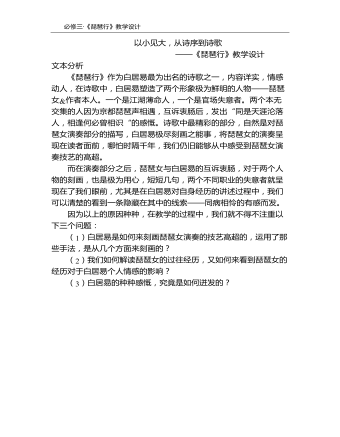
《琵琶行》教学设计
文本分析《琵琶行》作为白居易最为出名的诗歌之一,内容详实,情感动人,在诗歌中,白居易塑造了两个形象极为鲜明的人物——琵琶女&作者本人。一个是江湖薄命人,一个是官场失意者。两个本无交集的人因为京都琵琶声相遇,互诉衷肠后,发出“同是天涯沦落人,相逢何必曾相识“的感慨
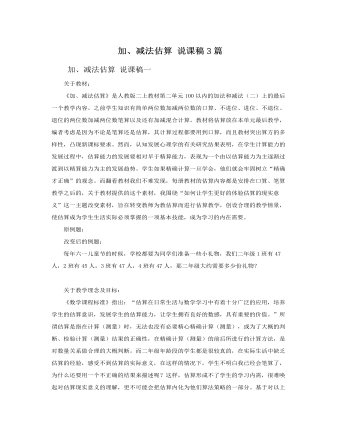
人教版新课标小学数学二年级上册加、减法估算 说课稿3篇
2、自主探究,学习例题(1)猜价格,感受新知课件演示乐乐一家来到商场的情景,让学生分别猜一猜热水瓶、烧水壶和杯子的价钱,在出示杯子的时候,我让学生算一算6个杯子,每个5元,一共需要多少钱?然后老师用一个普通讨论者的口气说:“买一整套会比单买一个要便宜一些,只要24元就可以买到了。”(2)同桌互相交流,培养合作精神先让学生任选两种物品和同桌互相说一说大约需要多少钱?再请个别学生拿着教鞭到黑板前指着自己想买的东西说一说我选了什么,大约多少钱,是怎样估计的。(3)小组讨论,学习例题1)、课件出示例题:妈妈打算买这三种生活用品,100元够吗?2)、学生独立思考,再小组讨论交流;3)、小组总结,汇报结果:请小组代表到黑板上展示学习过程,并引导学生用自己的语言说出估算方法和结果,对不同的方法进行鼓励;





















